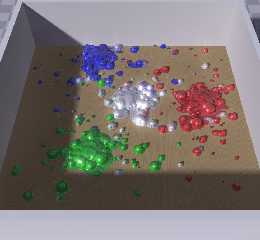|
 |
hua### [at] post3 tele tele dk news:3f3e6313$1@news.povray.org
> I guess you are storing the light_source location in a variable, and
> calculate the flare point from that in relation to the object.
nope, not exacly ;)
> The idea has potential. I'd like to see, for example, the ocean light
> up in pretty flares on a sunny day. In real life, THAT is so
> beautiful!
it's the next thing I'm planning to write now
> Will you calculate the ior values as well? And I expect it's
I thing current method should work with i.e. glass
> A kind of postprocessing would be great, too.
it is a postprocessing, a C++ program :)
btw - next version (now with small lanse-flares like in 35mm camera,
visible as small circles) I think animation with moving camera would be
very itneresting.
Currently it takes about 1 min to add flares/glows by my addon, and about 1
h to render image (due to complicated blob, and radiosity).
--
#macro g(U,V)(.4*abs(sin(9*sqrt(pow(x-U,2)+pow(y-V,2))))*pow(1-min(1,(sqrt(
pow(x-U,2)+pow(y-V,2))*.3)),2)+.9)#end#macro p(c)#if(c>1)#local l=mod(c,100
);g(2*div(l,10)-8,2*mod(l,10)-8)*p(div(c,100))#else 1#end#end light_source{
y 2}sphere{z*20 9pigment{function{p(26252423)*p(36455644)*p(66656463)}}}//M dk news:3f3e6313$1@news.povray.org
> I guess you are storing the light_source location in a variable, and
> calculate the flare point from that in relation to the object.
nope, not exacly ;)
> The idea has potential. I'd like to see, for example, the ocean light
> up in pretty flares on a sunny day. In real life, THAT is so
> beautiful!
it's the next thing I'm planning to write now
> Will you calculate the ior values as well? And I expect it's
I thing current method should work with i.e. glass
> A kind of postprocessing would be great, too.
it is a postprocessing, a C++ program :)
btw - next version (now with small lanse-flares like in 35mm camera,
visible as small circles) I think animation with moving camera would be
very itneresting.
Currently it takes about 1 min to add flares/glows by my addon, and about 1
h to render image (due to complicated blob, and radiosity).
--
#macro g(U,V)(.4*abs(sin(9*sqrt(pow(x-U,2)+pow(y-V,2))))*pow(1-min(1,(sqrt(
pow(x-U,2)+pow(y-V,2))*.3)),2)+.9)#end#macro p(c)#if(c>1)#local l=mod(c,100
);g(2*div(l,10)-8,2*mod(l,10)-8)*p(div(c,100))#else 1#end#end light_source{
y 2}sphere{z*20 9pigment{function{p(26252423)*p(36455644)*p(66656463)}}}//M
Post a reply to this message
Attachments:
Download 'metal_flare_2.jpg' (100 KB)
Preview of image 'metal_flare_2.jpg'

|
 |




![]()